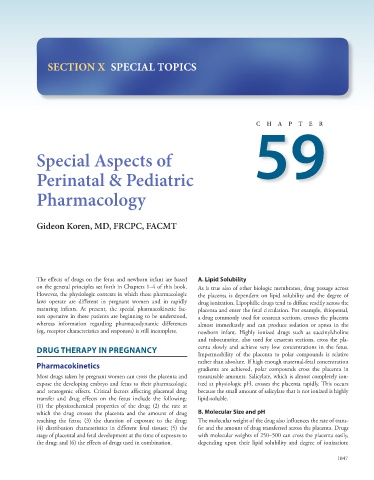Page 1061 - Basic _ Clinical Pharmacology ( PDFDrive )
P. 1061
SECTION X SPECIAL TOPICS
59
T
P
R
C
H
E
A
Special Aspects of
Perinatal & Pediatric
Pharmacology
Gideon Koren, MD, FRCPC, FACMT
The effects of drugs on the fetus and newborn infant are based A. Lipid Solubility
on the general principles set forth in Chapters 1–4 of this book. As is true also of other biologic membranes, drug passage across
However, the physiologic contexts in which these pharmacologic the placenta is dependent on lipid solubility and the degree of
laws operate are different in pregnant women and in rapidly drug ionization. Lipophilic drugs tend to diffuse readily across the
maturing infants. At present, the special pharmacokinetic fac- placenta and enter the fetal circulation. For example, thiopental,
tors operative in these patients are beginning to be understood, a drug commonly used for cesarean sections, crosses the placenta
whereas information regarding pharmacodynamic differences almost immediately and can produce sedation or apnea in the
(eg, receptor characteristics and responses) is still incomplete. newborn infant. Highly ionized drugs such as succinylcholine
and tubocurarine, also used for cesarean sections, cross the pla-
DRUG THERAPY IN PREGNANCY centa slowly and achieve very low concentrations in the fetus.
Impermeability of the placenta to polar compounds is relative
Pharmacokinetics rather than absolute. If high enough maternal-fetal concentration
gradients are achieved, polar compounds cross the placenta in
Most drugs taken by pregnant women can cross the placenta and measurable amounts. Salicylate, which is almost completely ion-
expose the developing embryo and fetus to their pharmacologic ized at physiologic pH, crosses the placenta rapidly. This occurs
and teratogenic effects. Critical factors affecting placental drug because the small amount of salicylate that is not ionized is highly
transfer and drug effects on the fetus include the following: lipid-soluble.
(1) the physicochemical properties of the drug; (2) the rate at
which the drug crosses the placenta and the amount of drug B. Molecular Size and pH
reaching the fetus; (3) the duration of exposure to the drug; The molecular weight of the drug also influences the rate of trans-
(4) distribution characteristics in different fetal tissues; (5) the fer and the amount of drug transferred across the placenta. Drugs
stage of placental and fetal development at the time of exposure to with molecular weights of 250–500 can cross the placenta easily,
the drug; and (6) the effects of drugs used in combination. depending upon their lipid solubility and degree of ionization;
1047

